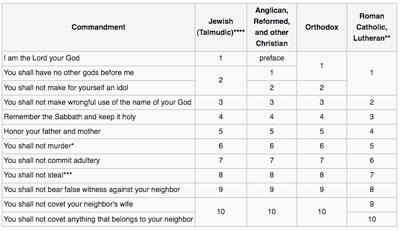2nd Sunday in Lent
Text of the readings
All reflections at Category: Lectionary
Exodus 20:1-17
 Exodus 34:28 indicates that the terms of the covenant is literally “ten words” (hence, better “decalogue”). We translate this as the “Ten Commandments”, but of course there are four different numbering systems of where the divisions of the commandments in fact occur (more info here). Another version is found in Deuteronomy 5:6-21. And then there is Exodus 34:11-27. Each commandment appears to have undergone its own complex development, with this final text possibly being post-exilic.
Exodus 34:28 indicates that the terms of the covenant is literally “ten words” (hence, better “decalogue”). We translate this as the “Ten Commandments”, but of course there are four different numbering systems of where the divisions of the commandments in fact occur (more info here). Another version is found in Deuteronomy 5:6-21. And then there is Exodus 34:11-27. Each commandment appears to have undergone its own complex development, with this final text possibly being post-exilic.
Psalm 19
1 Corinthians 1:18-25
The Mediterranean world was intrigued by paradox and reversal, but also believed, either through logic (Gentiles) or through God’s faithfulness (Israelites) that reality was predictable. Crucifixion runs counter to this world-view. Crucifixion is counter-cultural.
John 2:13-22

“Remembered” (John 2:17 & 22) are used to indicate the process of reflection and interpretation that the story has undergone in the lengthy process towards it being incorporated into this text. All the gospels record the cleansing of the Temple. The synoptic gospels place it close to Holy Week, relating it to being a cause for the growing antipathy against Jesus. John gives the raising of Lazarus this prominence. Roman denarii and Attic drachmas had pLiturgy › Add New Post — WordPressaortraits that would have been uncacceptable for paying Temple tax (cf. Matthew 17:27). Hence, moneychangers converted these into Tyre coinage which was acceptable (image – more here).
It appears Caiaphas may have introduced holding the animals, required for sacrifice, within the Temple complex, rather than outside its precincts.
The Amidah, or Shmona Esre, the eighteen benedictions central to Jewish liturgy, continues to pray at number fourteen Bo’ne Yerushalayim – asking God to rebuild Jerusalem with its temple and re-establish the Kingdom of David. This gospel text has a similar combination of temple and messianic expectation, but surprisingly within its Medditeranaean context connects it all to Jesus’ risen body.



